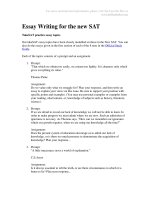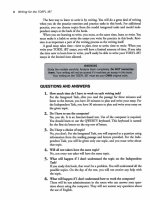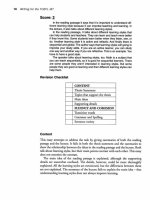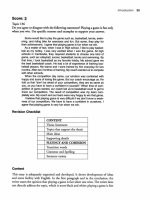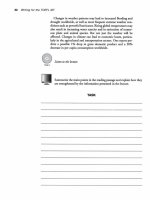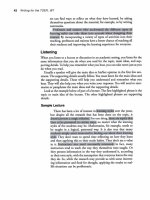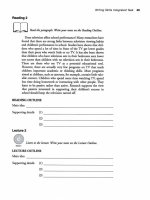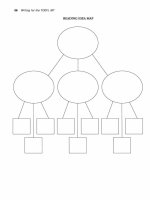Writing for the Workplace
Bạn đang xem bản rút gọn của tài liệu. Xem và tải ngay bản đầy đủ của tài liệu tại đây (290.68 KB, 47 trang )
SECTION
Writing for the Workplace
5
5
LESSON
Business
Writing
LESSON SUMMARY
What? You didn’t think you’d have to write once you
got out of school? Writing is actually a skill you will use
throughout life. Workplace writing is perhaps one of
the most important types of writing you will do after
you get out of school. In this lesson, you’ll learn how
writing for work is different from writing for school, and
how the two are similar.
“Fresh from college with a chemistry degree, I thought I had all the skills to excel in an entry-
level position in the analytical chemistry lab of a pharmaceutical company. But I soon discov-
ered that I would be spending significant time writing reports . . . .”
Lummis, Jean. “Teaching Technical Writing.” The Science Teacher, Vol. 68 No. 7 (October 2001).
ike this person, you might be surprised to learn that writing is so important at work. But think about
it for a minute: Is most of your mail from friends and family? Or, is most of your mail made up of
bills, letters from businesses,and advertising inserts? If you’re like most people, you get a lot of business mail.
Someone at a company wrote all that stuff. In fact, workplace writing begins even before you get hired—you
apply for a job with a cover letter, resume, and often an application form. And it doesn’t stop there. At work,
you will be expected to write e-mails, memos, business letters, reports, and even performance evaluations—
if not for people you supervise, then probably for yourself. It all adds up to lots of writing at work.
Business Writing LESSON 15
BETTER WRITING RIGHT NOW!
139
1
1
5
5
L
L
W
HAT
I
S
B
USINESS
W
RITING
?
So far, this book has discussed writing generally—with some focus on papers you might be required to write
for school. However, there are many different types of writing. For example, pull out the manual to a soft-
ware program and read a paragraph. Notice how the writing in the manual is quite different from the writ-
ing you find in your local newspaper. Cookbooks, mystery novels, and poetry are all very different kinds of
writing, too. Similarly, business writing has some special characteristics. Let’s look at some the characteris-
tics that make business writing different from other types of writing.
■
What? Whether it’s a proposal for a new product or a memo about your company’s break room,
your topic is almost always focused on some aspect of the business.
■
Who? You might be writing to your boss, coworkers, clients, customers, or vendors—unless you
are in public relations, you’ll usually be writing to someone related to the business.
■
How? Directly, briefly, clearly, purposefully—business writing is very focused and practical. Say
what needs to be said as efficiently as possible so you don’t waste your reader’s time! To help keep
business writing focused, there are a number of standard formats and styles used in business.
You’ll learn about several of these in the rest of this section.
W
RITING
I
S
W
RITING
Although there are some conventions specific to business writing, most of the strategies for good writing that
you’ve learned so far in this book still apply. In business writing, you should plan what you will write before
you begin writing. You can use the prewriting strategies in Section I to help you organize your thoughts. You
will also probably need to draft more than one version of your letter, memo, e-mail, or report. Section II walks
you through the basic steps of drafting. Finally, revising is as important to business writing as to other forms
of writing. In fact, since more people will probably read your business writing and your reputation as a busi-
ness person depends on it, revising is probably even more important in your business writing than it is in
writing for school. Use the checklists and tips in Section III when revising your business writing.
BETTER WRITING RIGHT NOW!
LESSON 15 Business Writing
140
LESSON
Writing
Resumes and
Cover Letters
LESSON SUMMARY
Even if you don’t have a job today, you still need to
know something about business writing—if you ever
plan to get a job. Most people’s first adventure with
business writing comes in the form of writing a resume
and cover letter. In this lesson, you will learn the basics
of resume and cover letter writing.
efore you ever start a job, you will begin practicing your business writing skills. Resumes and cover
letters are key tools to getting a job. Here’s what they are and how to get started writing them.
W
HAT
I
SA
R
ESUME
?
A resume is a concise, factual summary of your credentials. Your resume should fit on one page and should
be tailored to the job you are looking for. Although you may have one standard resume that you give to com-
panies, you will probably have different versions of your resume depending on the company and the job you
are applying for.
When you customize your resume to the job and position, you increase your chances of getting an inter-
view. Of course, it takes more time to write a separate resume for every position you are interested in, and it
may not be feasible to do this if you are applying for a large number of jobs at one time. Whenever possible,
however, you should try to tailor your resume to the position and company you are sending it to.
Writing Resumes and Cover Letters LESSON 16
BETTER WRITING RIGHT NOW!
141
1
1
6
6
B
B
H
OW TO
W
RITE A
R
ESUME
There are several formats that a resume can follow. Here are the basic categories of information that can be
included in your resume—all of this information may not fit on one page, so you will have to decide which
information is most important for your purpose.
Writing a resume is not a one-time event. Your
resume will change over time and for different
purposes. It’s a good idea to keep an ongoing record
of your skills, jobs, and other credentials. Then, use
your list to help you keep your resume up to date.
Heading. Your heading goes at the top of your resume. It includes your name, address (both your school
and your permanent address if they are different), telephone number, and e-mail address. To save space, you
can run some of this information, such as your address, phone number, and e-mail address across one line.
It’s often a good idea to have your name stand out: use a larger type size and boldfacing.
Summary. Some resumes include a summary, but in most cases this is not needed and takes up valuable
space that could be better used in another category. If you have an unusual situation or credential that you
want to explain—a summary is one place to do that. You can also use your cover letter for this information.
Objective. Many resumes include an objective that tells what kind of position you are looking for. Again,
this information is usually included in your cover letter, so you can omit this category if you have other items
you need to fit on one page.
Education. List any degrees or certificates you have received—with the most recent degree first. Include
the name of the degree or certificate, the name of the institution you received it from, and the date you received
it.You can also list your major and minor areas of study, your grade point average, special honors you received
upon graduation, projects or research you completed as part of your degree, and other types of related and
impressive information.
BETTER WRITING RIGHT NOW!
LESSON 16 Writing Resumes and Cover Letters
142
T
I
T
U
O
B
A
K
N
I
H
T
Make sure your dates and the other informa-
tion in your resume are accurate. A potential
employer is likely to check your facts. Never state
something in your resume that you can’t back up.
Experience/Work Experience. List past jobs, internships, and volunteer work you have done—with
the most recent experience first. Include the name of your position, the name of the company, and the dates
that you worked there. Below each job, summarize your responsibilities in the position. List your responsi-
bilities in order of importance—either by their importance to your job or by their relevance to the new job
you want.
Use action verbs to describe what you did. Include facts, dates, and try to quantify your experience as
much as possible. Quantifying your experience is using numbers or statistics to tell how many, how often,
how much, and so on. For example, rather than saying you increased the membership of a club, tell by how
much—by 50 students, by 20%, and so on. Rather than saying you worked with several offices, tell how many
offices you worked with.
When describing what you’ve done in the past
or your current job responsibilities, try to use
action verbs. Action verbs clearly show you as
the doer of specific actions. Here are some examples
of action verbs you might want to use in your resume.
Writing Resumes and Cover Letters LESSON 16
BETTER WRITING RIGHT NOW!
143
P
I
T
G
N
I
T
I
R
W
P
I
T
G
N
I
T
I
R
W
achieve
adapt
address
administer
advise
advocate
analyze
apply
appoint
appraise
approve
arrange
assemble
assess
assign
assist
attain
balance
begin
bring together
budget
catalogue
clarify
classify
collect
communicate
compare
compile
complete
compose
coordinate
conceive
conduct
consolidate
contract
contribute
control
correct
correspond
counsel
create
deal with
decrease
define
delegate
demonstrate
describe
designate
determine
develop
direct
document
draft
edit
educate
effect
eliminate
encourage
engage
enlarge
enlist
establish
estimate
evaluate
examine
expand
explain
expedite
facilitate
follow up
forecast
formulate
foster
found
gather
generate
guide
handle
help
identify
illustrate
implement
improve
increase
influence
inform
input
inspect
institute
instruct
integrate
interpret
interview
initiate
introduce
investigate
involve
launch
lead
learn
lecture
locate
maintain
manage
market
mediate
modify
monitor
motivate
negotiate
observe
order
organize
originate
participate
perceive
perform
pinpoint
prepare
present
BETTER WRITING RIGHT NOW!
LESSON 16 Writing Resumes and Cover Letters
144
process
produce
program
promote
propose
prove
provide
publish
purchase
put together
raise
receive
recommend
reconcile
recruit
reduce
reevaluate
refer
reinforce
remodel
reorganize
report
research
resolve
revamp
review
revise
schedule
screen
select
sell
solve
spoke
start
stimulate
structure
streamline
study
submit
succeed
suggest
summarize
supervise
supply
support
survey
teach
test
train
translate
transcribe
tutor
update
wrote
Writing Resumes and Cover Letters LESSON 16
BETTER WRITING RIGHT NOW!
145
Use the past tense of these verbs for jobs you no
longer do. It’s okay to use the present tense for the
things you do in your current job.
Extracurricular Activities/Other Experience. If you have other experience you want to highlight:
you were treasurer of a club, a member of student government, or held a leadership or other position of respon-
sibility in an association—you can list it here.As with your work experience, you should list your position or title,
the name of the organization, and your dates of involvement. Under each entry, summarize your responsibilities
in the position. You can list the experience in reverse chronological order as you do in the Work Experience sec-
tion. Or, you can list it in order of importance or relevance to the position for which you are applying.
Achievements/Awards/Fellowships. Here you can list any specific achievements, awards, scholar-
ships, fellowships, or grants that you want to highlight.
Special Skills/Other Skills. Under this heading, you might list fluency in a language other than English,
particular computer skills, or other special training you might have on office equipment or in a computer
programming language.
References. If you have space, list the full name, title, address, and telephone number of two to four peo-
ple who have agreed to be a reference for you. Make sure the people you list have agreed in advance and are
aware that you are using their names in your resume. If space on your resume is limited, it’s acceptable to
simply write “References available upon request.”You can also provide references on a separate sheet of paper
or on the company’s application form.
PRACTICE
Check your answers against the answer key at the back of the book.
1. Use one of the prewriting strategies in Section I to sketch out the information you might include in
your resume. Make a list of the categories you think you might use and the information you might
include under each category.
If you have experience or credentials that
just don’t fit into any of these headings, con-
sider making up one of your own. Make sure the
heading is clear and concise. Making up your own
heading has the advantage of emphasizing a partic-
ular skill set or experience you have that matches the
BETTER WRITING RIGHT NOW!
LESSON 16 Writing Resumes and Cover Letters
146
P
I
T
G
N
I
T
I
R
W
qualifications of the position you are seeking. Here
are some examples of other headings you could use
in your resume.
Accomplishments
Achievements
Career Profile
Career-Related Skills
Career Training
Community Service
Continuing Education
Computer Literacy
Honors and Awards
Internships
Language Proficiency
Leadership Skills
Licenses and Certification
Memberships
Military Experience
Presentations
Professional Development Seminars
Publications
Qualifications
Relevant Coursework
Summary of Skills
Supervisory Experience
Special Projects
Teaching Experience
Technical Training
Volunteer Work
Writing Resumes and Cover Letters LESSON 16
BETTER WRITING RIGHT NOW!
147
Let’s look at an example of a resume. (Additional examples can be found in the Appendix.)
Example
MELISSA R. RABIN
123 Cherry Blossom Drive
Palo Alto, CA 94304
(605) 555-7122, e-mail:
EDUCATION
CALIFORNIA COMMUNITY COLLEGE, Palo Alto, CA
Associate Degree, Business Administration, May 1999
EXPERIENCE
JOHNSON INSURANCE, Palo Alto, CA 1999–present
Administrative Assistant
■ Maintained all files for an insurance agency
■ Created and set up a new filing system used by three departments in the agency
■ Trained five other staff members on word processing software
MACY’S, Palo Alto, CA 1997–1999
Sales Associate
■ Sold clothing to customers and monitored inventory
■ Exceeded monthly sales quotas by 12%
MCI, Palo Alto, CA Summer 1996
■ Verified customer accounts and answered questions
HOPE SOUP KITCHEN, Palo Alto, CA Summer 1996
Project Manager
■ Stocked the food pantry, prepared and served hot meals to families, and cleaned the kitchen
and the dining hall two days per week
SPECIAL SKILLS AND AWARDS
■ Fluent in Spanish
■ Proficient in the use of Macintosh and IBM-compatible computers; familiar with MS Office
■ Most Valuable Team Player Award, MCI (July 1996)
BETTER WRITING RIGHT NOW!
LESSON 16 Writing Resumes and Cover Letters
148
Keep these tips in mind when you write your
resume:
Be concise. You don’t even need complete sen-
tences. Leave out pronouns, such as I, and start
with your action verbs. Your writing style should be
direct, clear, simple, and easy to follow. Get to the
point!
Keep the format easy to follow, too. You don’t want
a cramped, crowded resume. Leave some white
space and make the important information jump out
at the reader.
Be polite and formal. Avoid slang, clichés, con-
tractions, and informal language.
Use action verbs. Use the list in this lesson to help
you describe your experience. When you can, avoid
the passive voice and passive-like phrases, such as
“served as” or “functioned as.”
PRACTICE
Check your answers against the answer key at the back of the book.
2. Think about a job or other position you have had. Then, write an entry you could include on your
resume to tell a prospective employer about your experience in this position.
3. Create your own resume using the strategies in this lesson. Use the blank pages at the end of this
book for your work.
Writing Resumes and Cover Letters LESSON 16
BETTER WRITING RIGHT NOW!
149
P
I
T
G
N
I
T
I
R
W
P
UBLISHING
Y
OUR
R
ESUME
In the past, most resumes were typed on heavy weight stationery and mailed or hand-delivered. Today, you
have more options for publishing your resume. Here are the pros and cons for each option.
FORM PROS CONS
Paper resume intended You can use design and layout features to It’s difficult for companies to scan
for traditional mail or highlight your qualifications and make your resumes with design features. You
hand delivery resume stand out from the crowd. Paper can go overboard designing your
resumes are easy to mail, fax, attach to an resume and turn your potential
application, or hand out when you visit a employer off. Besides, it takes skill
company. and time to produce such a
resume.
Scannable resume— A scannable resume has few design features It’s more difficult to get your
intended for a computer and takes a short amount of time to put resume to stand out from others.
to scan into a database together on a computer. It also requires little
design or word processing skill. These
resumes can be submitted by mail, fax, or
e-mail. They are easily scanned by a
company’s computer. The company can then
search a large number of resumes for
keywords in searching for a candidate. Many
companies require a scannable resume. If
yours isn’t scannable, you may not be
considered for the job.
Electronic resume Electronic resumes can be submitted to You’ll need to print your resume to
companies by e-mail, through the company’s hand it out or mail it to others.
website, and via other recruiting websites.
It’s also very portable and easy to manipulate
and update. Electronic resumes with little
formatting are scannable.
Web-based resume These resumes can be posted online and Web-based resumes can be more
(included in a website) may attract more readers—although not difficult to print. You need to know
necessarily a more targeted group of how to design and author a
readers. You can add hyperlinks to your website. You’ll also need access
resume and fancy design features that are to a Web hosting service.
not available in other media.
BETTER WRITING RIGHT NOW!
LESSON 16 Writing Resumes and Cover Letters
150
W
HAT
A
RE
C
OVER
L
ETTERS
?
Have you ever responded to a “want-ad” in the newspaper? If so, you probably sent the company a letter telling
them about your interest in and qualifications for the job along with your resume. A cover letter is an intro-
duction to your resume and a request to be interviewed for a job. It’s an opportunity for you to highlight
specific experiences or qualifications you have that aren’t explained in your resume. Unlike a resume, a cover
letter is subjective—it’s your opinion of how your background prepares you for the job. Moreover, a
cover letter is often the first encounter you have with a company, so you want to make good first impression.
H
OW TO
W
RITE A
C
OVER
L
ETTER
Like all forms of business writing, cover letters have a specific format and style. A standard cover letter usu-
ally has four paragraphs.
PARAGRAPH 1
The main purpose of the first paragraph is to convince the reader to keep reading.You should introduce your-
self to the employer: explain your purpose in writing and name the job or position you want to be consid-
ered for. If you know of a specific job opening at the company, you should tell how you heard about the open-
ing in the first paragraph—from a person, from an ad in the newspaper, from the company’s website, from
a career fair, and so on. This is also the place to mention any other ties you have to the company—for exam-
ple, if someone you know works for the company and recommended that you apply for the job, you might
mention the person’s name in the first paragraph.
Examples: You might find these types of sentences in the first paragraph of a cover letter.
■
This letter is to express my interest in . . .
■
I am very interested in working for XYZ Company as a . . .
■
I would like to be considered for XYZ Company’s Credit Manager position . . .
■
I recently read your announcement in the Times for a . . .
■
I recently received some information about an opportunity to work at XYZ Company . . .
■
Lee MacDonald, a former associate of yours, recommended that I contact you about . . .
It’s important to personalize each cover let-
ter. Here are some ways to personalize each
letter.
➧ Address the letter to a person. Try to find the
name and title of someone who works at the com-
pany. You might have to call the company and ask
for the name of someone in Human Resources, in
Writing Resumes and Cover Letters LESSON 16
BETTER WRITING RIGHT NOW!
151
P
I
T
G
N
I
T
I
R
W
Personnel, or in the department you want to work
in. If you absolutely cannot find a person to address
your letter to, then it’s acceptable to address your
letter to Sir/Madam—but it’s not nearly as effective
as addressing a specific person.
➧ Use a different cover letter for each job inquiry.
Although there are some cases in which a mass mail-
ing of a form letter works, in general, you should
write each cover letter with a specific company and
job in mind. You can often recycle parts of a stan-
dard cover letter or an inventory of your skills. How-
ever, every company and every job are different—and
your cover letter should reflect that.
PARAGRAPH 2
In the second paragraph, you should show how you are a good match for the company. Often, this will require
doing some research on the company beforehand.
Examples: You might find these types of sentences in the second paragraph of a cover letter.
■
I am a good match for XYZ Company because . . .
■
Based on my research, I am convinced that my values are a good match with those of XYZ Com-
pany. For example,...
■
I have the skills to do a good job at XYZ Company. For example,...
■
I am particularly well-suited to working at XYZ Company because . . .
Keep your reader’s point of view in mind as
you write. Your writing should focus on the
employer’s needs. Rather than telling all the
things you hope to learn from the company or the
things you hope to get from the company, stick with
what you can do for the company.
BETTER WRITING RIGHT NOW!
LESSON 16 Writing Resumes and Cover Letters
152
P
I
T
G
N
I
T
I
R
W
PARAGRAPH 3
Here, you should give specific details about yourself and show how they relate to the job you are applying
for. You want to show that you are qualified to do the job well.
Examples: You might find these types of sentences in the third paragraph of a cover letter.
■
My major is in business, and I have taken a number of courses in computer programming . . .
■
I have taken a number of classes in statistics, and I used statistics in my senior project . . .
■
I have served as a language exchange partner in conjunction with the Intensive Language
Institute . . .
■
I recruited volunteers for and managed a project at XYZ Charities . . .
■
As you can see from my resume,...
Support your claims with specific examples.
Instead of Back it up
saying this: with examples like this:
I am a quick I am a quick learner. This past
learner. summer, I was commended by my
supervisors at XYZ Company for
my ability to learn about the orga-
nization and contribute to pro-
jects in a relatively short amount
of time.
I am a leader I am a leader at school. As Pres-
at school. ident of the University Math Club,
I implemented several new pro-
grams, such as peer tutoring
and a math competition—and in-
creased membership by 30%.
I am a good I am a good team player. In fact,
team player. my supervisors at XYZ Company
said that my teamwork skills are
one of my strongest qualities and
Writing Resumes and Cover Letters LESSON 16
BETTER WRITING RIGHT NOW!
153
P
I
T
G
N
I
T
I
R
W
stated that I did an outstanding
job collaborating with coworkers
on my last project.
No matter what No matter what a job demands, I
a job demands, am willing to work hard to suc-
I am willing to ceed in that position. Unlike most
work hard to of my peers in the car insurance
succeed in that business, I entered the field with
position. little knowledge of cars and
claims adjusting. And yet, I
advanced rapidly. I consistently
completed training courses at the
top of the class. I also sought out
mentors within the organization
and spent extra time before and
after work asking questions and
practicing my adjusting skills. I
completed additional courses in
my spare time.
I have a lot of I have a lot of experience helping
experience help- my peers. I was a student adviser
ing my peers. for three semesters and a mentor
for transfer students for two
semesters. I also tutored other
students at the Learning Skills
Center.
PARAGRAPH 4
The last paragraph is your conclusion. As with all writing, you want to conclude with a take-home message.
Your take-home message will usually be that you are qualified for the job and would like to interview for the
BETTER WRITING RIGHT NOW!
LESSON 16 Writing Resumes and Cover Letters
154

